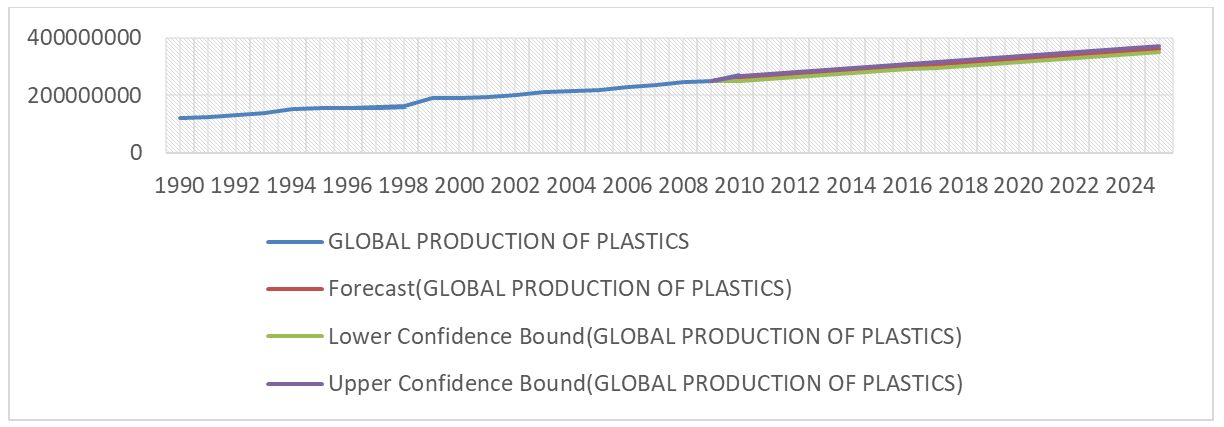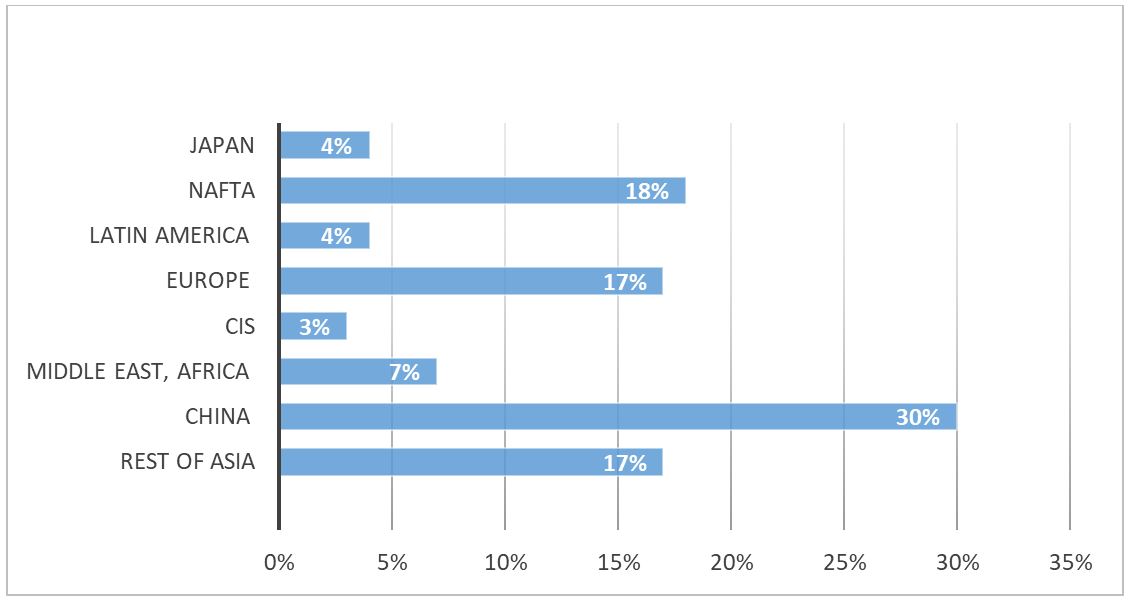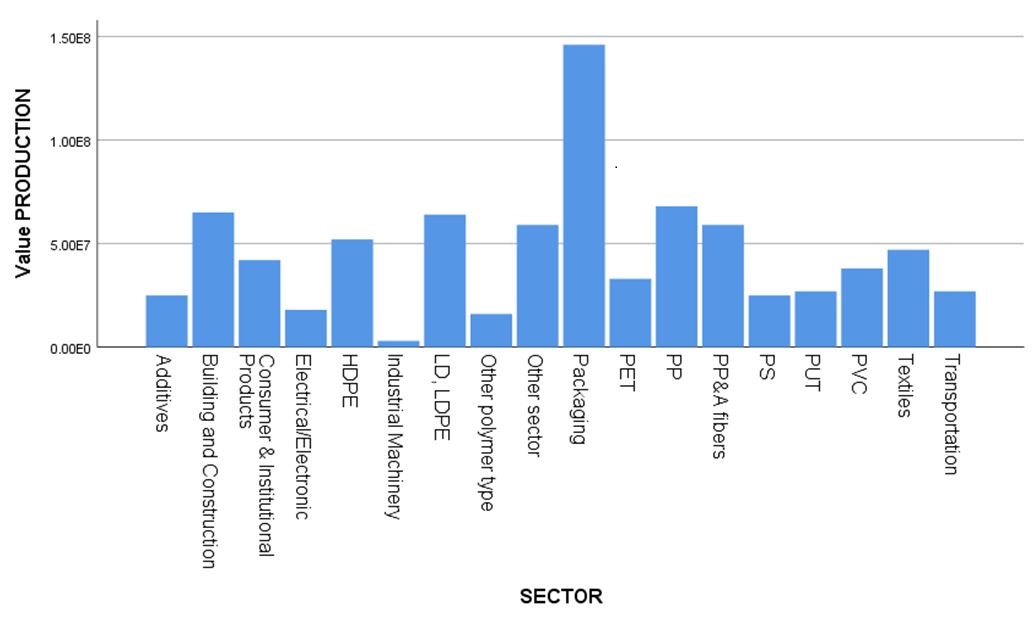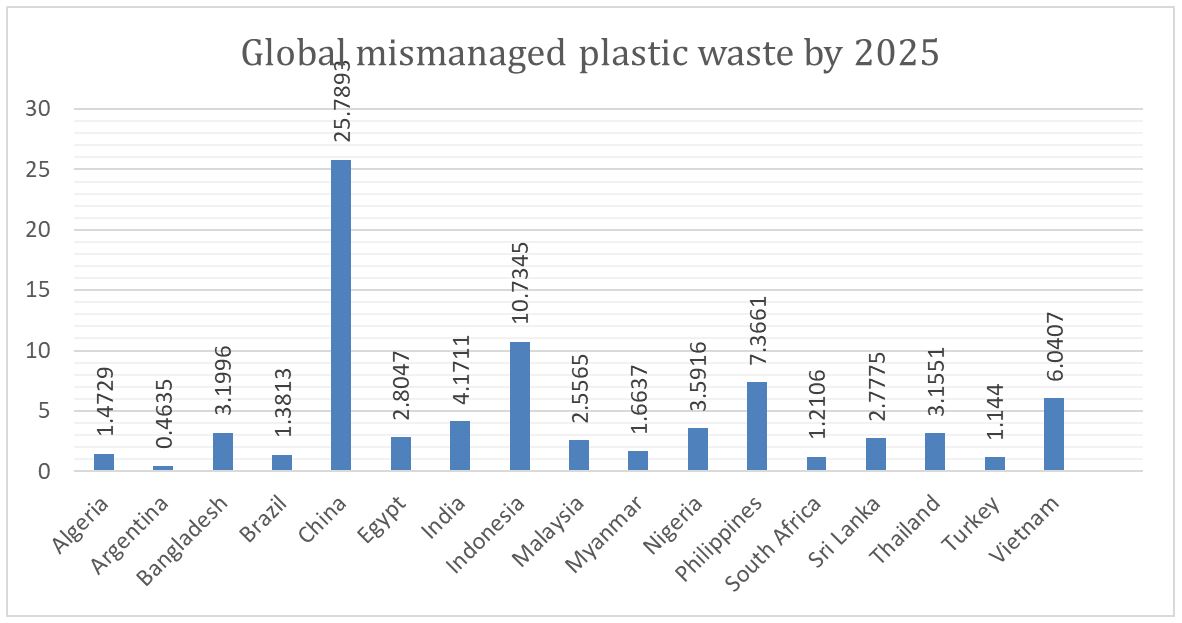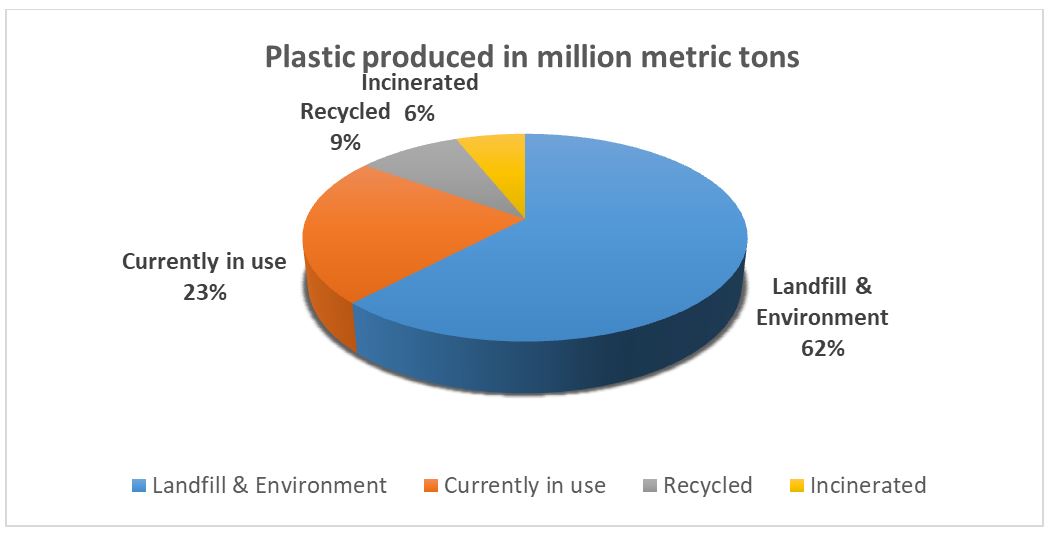A Critical Analysis of the Rising Global Demand of Plastics and its Adverse Impact on Environmental Sustainability
The paper critically examines the rising global demand of plastics including the role of major countries responsible for the mismanaged plastic waste by 2025. It also outlines the growing importance of adopting Plastic Replacement Alternatives as global solution to mitigate plastic pollution. Plastic pollution affects the health of millions of people around the world. Synthetic plastics are slow to degrade posing a huge threat to the entire ecosystem. Recent studies conclude that human beings are daily consuming bits of micro-plastics through food and water. Micro-plastics have also been found in 90% of the packaged drinking water. Approximately 9 million tons of plastic waste is disposed annually and it is expected to double by 2025. If present trend continues there will be more than 18 billion metric tons of non-biodegradable plastic both in land and oceans. Also, due to recent Covid-19 pandemic, there is a sudden increase in demand for single-use plastic items. The problems related to post pandemic plastic pollution will become even more complex requiring a collaborated and sustainable approach in collection and effective disposal of plastic waste in order to mitigate its harmful impact on the environment.
Keywords: Plastics; Global; Demand; Mismanagement; Pollution; Biodegradable Alternatives; Sustainability
Plastics are one of the most versatile man-made material. It has been reported that more than 2 million plastic bags and bottles are currently being consumed by packaging industry every day. Plastics are currently in demand in all the sectors. The current demand for plastics in packaging industry is around 36% followed by building and construction at 22% and the rest 42% required in other key sectors such as electronics, furniture, transport, agriculture, medical, toys, etc. The future production of plastics is set to double by 2030 [1]. Due to slow rate of degradation and inappropriate disposal mechanism there is gradual accumulation of global mismanaged plastic waste in the environment. The accumulated plastic waste is continuously broken down into toxic micro-particles by extreme weather conditions causing irreparable damage to the entire ecosystem. It is also responsible for polluting freshwater bodies and other habitats [2]. More than 9 million tons of plastic waste is dumped in the oceans every year which is expected to double by 2030 [3]. Plastic waste dumped in oceans and water bodies is causing high risk to the aquatic life. It is also found that quantity of plastic remains/debris is six times more in relation to the quantity of oceanic planktons (flora) which produce 70% to 80% of total oxygen on earth. Also, plastic debris has also been found inside the gut of dead marine animals. Fishes and other aquatic animals are directly consuming micro particles of plastics which smell as food covered by algae and fungi. This plastic is getting accumulated in the gut and tissues overtime which is causing death of many fishes and other aquatic animals due to starvation. Therefore, it is also affecting the food chain in the entire ecosystem. According to a recent study on marine species there will be acute shortage of sea food if dumping of plastic waste materials is not controlled in the coming years [4].
Plastic term comes from the Latin word ‘plasticus’ and the Greek word ‘plastikos’ signifying ‘ready to be shaped’ or ‘formed.’ Plastics are largely used as packaging materials [5]. Plastics have substantial benefits in terms of being light weight, durable, flexible and cost effective as compared to other alternative packaging materials [6]. Plastics are among the most sought after man-made material [7]. According to European Bio plastics, there are more than 30 types of plastic polymers. About 95% to 99% of these plastics are derived from petroleum sources while the rest 3-5% are derived from biodegradable (compostable) plant sources. The commonly used plastics are mostly derived from non-renewable sources such as polypropylene, polyethylene, polyvinyl chloride and poly (ethylene terephthalate). On the other hand, biodegradable plastics are produced from renewable plant sources, recycled food waste, by-products including compostable and oxy-biodegradable plastics etc. Plastics are commercially used in many sectors including manufacturing, construction, medical industry, packaging, agriculture, furniture, household appliances, electronics etc. Currently 85% of plastics are used in the production of medical equipment’s including surgical gloves, disposable syringes, sterile packaging for medical instruments, dental implants and bridges, catheters, joint replacements, intravenous bags, insulin pens etc. In addition, 70% of the ‘single-use plastic’ is commonly used for packaging purposes.
However, there are significant challenges related to economic, social, technological and environmental implications of production and consumption of plastics. There is gradual accumulation of discarded plastics in landfills and oceans [8]. Plastic waste can physically harm wildlife. According to [9], plastic debris can be found littered on beaches, floating on the surfaces, and submerged at the bottom of all water bodies. Micro-plastics are often eaten by aquatic animals as food covered by algae. It is majorly responsible for filling their guts causing death due to starvation. There is significant evidence regarding the harmful effects of accumulated plastic garbage on 300 aquatic species including 90% of ocean turtles, 40% of seabirds, and 70% of marine animals. Improper disposal of plastic waste is also affecting tourism sector in many ways. Recycling is an effective waste-management strategy, although very limited amount of the plastic has been recycled till now [10]. Asian countries with growing consumer markets are responsible for more than 70% of the plastic pollution. Ironically, substitutes like wood, metal and glass contribute to significantly higher environmental costs as compared to plastics. Therefore, there is a need for thorough investigation regarding the environmental impact of plastic production, consumption, disposal and availability of substitutes to mitigate plastic pollution [11]. A recent report by BCG & WWF 2020 proposes an International Treaty with support from corporates to accelerate global efforts to tackle plastic pollution.
1. To forecast global demand of plastics by 2025. 2. To forecast global mismanaged plastic waste by 2025. 3. To outline the growing need and importance of Plastic Replacement Alternatives (PRA’s) to mitigate plastic pollution.
It is an exploratory study based on identifying the underlying issues related to plastic production, consumption patterns and applications in various industries. Secondary data was qualitatively analyzed using statistical software for forecasting global demand of plastics, identifying major countries responsible for mismanaged plastic waste and exploring plastic replacement alternatives as solutions to tackle the growing plastic pollution around the world.
The resurgence of global plastic industry has been witnessed since World War II. The global demand of plastics has increased 10 times in last 30 years. The global plastics market was valued at $570 billion in 2019. It is expected to grow at 5 percent every year. Plastic production growth rates indicate that production could double by 2025 to increase four times by 2050. Asian countries accounts for more than 70% of the global plastics production and consumption.
Global plastic production is forecasted from 310 million metric tons since 2014 to 375 million metric tons by 2025 [12]. The consumers market for plastic products and its application in packaging industry is estimated at $270 billion by 2025.
The above figure depicts the global production of plastics from 2019-2020 for the following countries: Japan, NAFTA, Latin America, Europe, CIS, Middle East, Africa, China, and Rest of Asia (Source: Statistical 2020)
China is the leading producer and exporter of plastic products/ materials with 30% of total production followed by rest of Asia including India, Indonesia, Vietnam, Philippines, Japan, Sri Lanka, Thailand and Malaysia. China contributed around 7 million metric tons of plastic in July 2020 representing almost 33% of absolute global demand for plastics (Statistical 2020). In recent times, developing economies have become the production hub of plastic products exported overseas. The following countries having high per capita consumption of plastics: Korea, Israel, Canada, United States, Western Europe, Japan, China, Saudi Arabia, Mexico, Brazil, India and Africa. Asia is the largest contributor to global domestic plastic waste [8].
Plastics being cost effective are virtually in demand across all key sectors: cosmetics and personal care, packaging, transportation, building & construction, textiles, consumer products, electrical and electronic applications, and production of capital goods.
The above figure depicts industrial global demand of plastics (million tonnes per year)
As per the graph Polyethylene is most commonly used in the packaging industry recording highest production of around 150 million tons in the year 2018-2020. It includes single-use plastics like bottles, plastic bags, plastic films, containers etc. There are different types of polymers of Polyethylene: HDPE, PP, PS, LDPE, and LLDPE. Plastics are also increasingly used as packaging material in super markets which maintain hygiene, freshness, quality and increase the life span of perishable food items. The global plastic packaging market is expected to increase to $270 billion by 2025 [13].
The degree of durability of plastics depends upon their uses and applications. For instance, plastic materials used in building and construction can last for more than 35 years; plant, machinery & equipment lasts almost 15- 20 years; electronic plastic products/ components usually last for 8-10 years; textiles up to 5 years; disposable plastic cups and related items are usually discarded after single use whereas plastic food and drink containers, lunch boxes, cosmetics, medicines packaging usually lasts up to 2-3 years. Also, plastic polymers are perceived as a valuable material for the production of disposable medical plastic packaging materials, gloves, and personal protective equipment etc. Because of increasing demand of plastics in various sectors, competitive rivalry among producers is also high. Companies are focusing on expanding existing capacity to create economies of scale thereby offering a diverse mix of product portfolio for increased profitability. Due to the recent pandemic, reduction in oil prices has also adversely affected the global demand of recycled plastics which are comparatively costlier than virgin plastics. Growth of plastic industries in emerging markets such as Philippines, Brazil, Indonesia, China, India, and Mexico have been instrumental in fueling the global demand for plastics.
Mismanaged plastic waste (MPW) is contaminating the world’s water bodies causing water logging and floods, transmitting vector-borne diseases, increase in respiratory problems, allergies etc. due to toxic emissions from combustion of waste plastic material thereby causing harm to the entire ecosystem. Plastics in the global ecosystem can be segregated into three categories: currently in-use plastics, plastic waste managed through recycle or re-use, and mismanaged plastic waste. Mismanaged plastic waste (MPW) is characterized as “plastic that is either disposed of or insufficiently arranged causing harm to the environment. Inadequately disposed plastic debris threatens habitat and aquatic life [7].
The Figure depicts the forecasted global mismanaged plastic waste by 2025 for the following countries: Algeria, Argentina, Bangladesh, Brazil, China, Egypt, India, Indonesia, Malaysia, Nigeria, Philippines, South Africa, Sri Lanka, Thailand, Turkey, and Vietnam. (Source: Statistical 2020)
As per the estimate, China contributed to 25.78% of the total global mismanaged plastic waste followed by Indonesia at 10.7%, Philippines at 6.3% in the oceans [14]. Approximately 345 million tons of plastic waste is produced every year. Plastics are made from polymers which are also responsible for contributing to issues related to global warming and climate change. Packaging material comprises of 47% of the total mismanaged plastic waste. Textile sector contributes almost 17% of the global waste. 75% of discarded textiles are either incinerated or land-filled and the rest 25% is recycled.
It can be observed in the graph above that majority of mismanaged plastic waste is either discarded in landfills or dumped into oceans causing serious damage to the environment. More than 8.5 billion tons of plastic waste was disposed between 1960 and 2020, out of which only 12% has been incinerated, 9% recycled and almost 79% discarded in landfills, oceans or environment.
Asia is the largest contributor of global plastic waste, generating more than 73 million tons followed by Europe, North America and Latin America. More than 8 million tons of plastic is dumped in the environment every year and majority of this plastic waste comes from countries such as China, Indonesia, India, Malaysia, Nigeria, Philippines, Vietnam, Sri Lanka and Thailand. According to recent study plastic pollution from landfills and incineration generates approximately 450 million tons of carbon dioxide yearly. Landfill is the traditional approach to waste management practiced in most of under-developed and developing countries. The 4 Rs’ strategy that has been implemented as waste management practice- i.e. reduce, reuse, recycle and recover considers landfill as the least desirable strategy [15]. Landfills also suffers from another major disadvantage. Landfill eliminates the opportunity to recover or reuse the discarded plastics. On the contrary incineration reduces the need for landfill, however it leads to toxic emission of poly-aromatic hydrocarbons, CO2, dioxins etc. which are directly released into the atmosphere causing air pollution and global warming. According to a study, only 9% of the plastic in the world has actually been recycled till date, which means that 91% of the plastic has not been recycled at all. Recycling of mismanaged plastic waste is the best alternative to protect the environment from harmful emissions. Also, recycling reduces carbon dioxide emissions by about 0.8 tons [16]. Thermal treatment is another method to eliminate plastic waste permanently.
The figure depicts that the Fate of mismanaged global plastic waste under landfill & environment, currently in use, Recycled, and Incinerated. (Source: Plastics Europe Market Research Group)
Due to Covid-19’ demand for disposable gloves, masks, plastic cups, coffee stirrers, straws, and other personal protective equipment (PPE) has increased tremendously since last six months. Due to improper disposal, they are found littered on the streets, public places, near hospitals, garbage heaps etc. which can further lead to cross contamination. According to a recent study viruses were found to sustain longer on plastic surfaces and items in comparison to metals, paper or cardboard. Strains of certain viruses were detected even up to 72 hours on plastic surfaces. It was therefore concluded that paper bags might be safer as compared to plastic bags [17].
Plastic recycling rates vary across countries. In India 60 percent of plastic is recycled rest 40 percent is either disposed in landfill or incinerated. Plastic recycling rates in other countries: 47% in South Africa, 45% in U.K., 28% in China, 27% in Japan, 11% in Indonesia, 10% in Canada, 6% in Israel and 10% in the United States. Nine Countries in Europe that have imposed a complete ban on landfill are: Sweden, Netherlands, Switzerland, Norway, Belgium, Denmark, Luxembourg, Germany, and Austria. These countries have more than 95% recovery rate of discarded plastic waste. However, during Covid-19 pandemic, the amount of single-use plastic discarded might not get recycled at all due to inadequate number of municipality waste services in developing countries.
Currently, there is a growing need for countries to adopt an integrated approach to adopt the 7R’s model of sustainability which advocates effective disposal mechanism of plastic waste by different methods/ processes [18].
The figure explains the 7Rs’ Circular Economy Model named as Replace, Redesign, Re-modify, Recover, Repurpose, Recycle, and Refuse.
The primary objective is to combine forward integration approach in the 7R’s model for sustainable development and conservation of environment. The basic idea is to incorporate the 7R’s model during the new product development process so as to reduce the plastic footprint and its adverse impact on the environment. It can be achieved through extension, adaptation and modification to lengthen the product life cycle stages, design thinking, exploring renewable alternative sources of energy and fuel, focusing on increased use of by-products to create biodegradable plastics/ products, technological collaborations and adopting sharing economy model for community development [19]. Benioff Ocean 2020 Initiative have pledged $11 million to targeting river plastic pollution.
In the past numerous initiatives have been undertaken at global level to redesign, refuse, eliminate, reuse or recycle the consumption of plastics through closed-loop system also known as circular economy model [20]. It has also been emphasized that single-use plastic items should come along with pollution causing labels [21]. World Bank (2018) announced that global plastic waste is expected to increase by 70% if proper measures are not adopted to reduce plastic pollution. Countries are undertaking stringent regulations related to mismanaged waste that adversely affects the health of millions of people around the world [22]. Countries around the world have adopted an integrated approach of 7R’s Model through stringent reforms and regulations. For instance, in Western Europe and Japan, about 96% of plastic waste is collected and recovered at source. Also, there is complete ban on discarding waste plastic in landfills or oceans. They have also introduced plastic bottles deposit scheme for consumers to facilitate recovery at source. The countries such as U.S.A and Australia have 80% of waste collection average and depend on landfilling or incineration as waste management strategy. Germany has the highest recycling rate of 57% followed by South Korea, Austria, Wales and Switzerland. Emerging economies like China, India & Brazil with increased industrial activity have only 50% waste collection average. Manual collection of waste material is more prevalent and large amount of waste is discarded in landfills or water bodies informally leading to plastic pollution. Most of the countries are imposing strict trade restrictions on import of single-use non-biodegradable plastics as a preventive measure to curb pollution. Instead countries are introducing new regulations permitting imports of only approved oxy-biodegradable single-use plastics and packaging materials which can be easily degraded in the presence of oxygen. Countries like Saudi Arabia, Albania, Jordan, Yemen and United Arab Emirates are the leading countries which have enforced stringent regulations allowing imports of only oxy-biodegradable disposable plastics. The samples of the plastics imported are further tested in the pre-approved labs to ensure that they are oxy-biodegradable. However, whether the oxy-biodegradable plastics actually degrade in the presence of oxygen in a short span of time without causing air or water pollution is yet to be fully established.
Countries such as United Kingdom, Canada, Taiwan, European Union, U.S., India etc. are taking preventive measures to ban the sale of plastic straws, drink stirrers and other single-use plastic products. United States plans to adopted circular economy by recovering and recycling 100% of all used plastic packaging by 2040. In 2016-17, France restricted the free distribution of single-use plastic thereby eliminating the use of more than 5 billion plastic grocery bags. Canada in 2018 adopted the principle of Zero Plastic Waste by introducing complete ban on single-use plastics by 2021 and developing responsibility programs designed to reduce, redesign, recycle, recover and reuse. India as an emerging economy with a population of 1.3 billion, is a significant contributor to plastic pollution due it’s convenience and cost effectiveness. India’s per capita usage of plastics stands at 11.5 kgs. However, India is reducing the use of polythene bags made of virgin or recycled plastic less than 50 microns in thickness and plans to ban all single-use plastics by 2022. Plastic due to its durability, thermal resistance and highly resilient nature finds multiple uses in building and construction industry. Companies are also taking initiatives to recover ocean plastics to manufacture sneakers, jackets, comforters, sportswear, bags etc. from recycled ocean plastic debris. Plastic toothbrush takes 100 to 300 years to degrade. Therefore, bamboo toothbrush are other eco-friendly substitutes which are currently available in the markets. The need of the hour is to educate the consumers regarding the harmful effects of plastic pollution so that they adopt biodegradable alternatives. With the introduction of ban on polythene retailers have started using jute/ cloth/ paper bags in place of plastic carry bags. In many countries, single-use plastics will be prohibited in both semi urban and urban communities by 2021.
Plastics are extremely versatile and unavoidable due to their multiple uses and characteristics. But the level of harm it is causing to our environment, because of its non- biodegradable nature, has forced countries to invest heavily in R&D labs, to seek compostable eco-friendly plastic alternatives. However, the main limitation of compostable products is that they require industrial treatment in compostable industrial centers/ facilities which are also limited in number. For the last two decades, there has been an emphasis on living “green” and exploring environment friendly plastic alternatives. There is an urgent need to shift the focus to biodegradable alternatives to reduce the menace of plastic pollution. For example- Starch as a totally bio-degradable, low cost natural polymer has been receiving lots of attention these days. Starch when blended with aliphatic polyesters can be used to produce completely biodegradable as well compostable trash bags. These bags decompose when they come in contact with soil and are safe as fodder for animals also. They are economical to produce, but the starch content has to be more than 60% of the composite, in order to make it easily degradable [23]. Increased usage of potato/ corn starch in making compostable trash bags can drastically help in reducing plastic pollution. Replacement of plastic bags with cotton bags, made from 100% biodegradable material, cotton mesh is increasingly being used. Likewise, biodegradable plastics made from sugar and carbon dioxide could safely be used in producing medical implants. Production of biodegradable plastics from microalgae as well as use of ground coffee precipitate/ residue can be effectively utilized for reducing plastic consumption. Also, the use of bars instead of plastic shampoo bottles, detergent and other liquids are other possibilities to reduce plastic footprint. A company in New Zealand named Ehique makes soap bars from coconut oil and other such essential oils. Seeds of olives which are usually discarded in the production process can be used to produce biodegradable plastic products, which can easily be decomposed into fertilizers within one year [24-30]. Limex made from calcium carbonate can also be used as a substitute for plastic. Moreover, the basic raw material used in this is limestone, which is abundantly available in many parts of the world. Bamboo and sandalwood are also in use to create biodegradable water bottles which have shelf life of about two years.
Single use plastics and packaging material are one of the major cause of environmental pollution which has lead countries and communities to focus on producing biodegradable plastic products. For example- most commonly used packaging materials used today are made from foaming technology and Nano-cellulose. Plastic straws take somewhere between 450 years to decompose so biodegradable straws are being produced made from plant parts, grass, bamboo and metal [31-35]. Companies are also investing heavily in nanotechnology used for making packaging material of paper or cardboard. There has been a focus on creating edible cutlery. Not only our environment, but also our bodies are getting damaged with excessive use of plastics. As it is observed that 90% of packaged water bottle contains traces of plastic therefore, edible water bottles are being produced from sea weed extracts. Also paper bottles are replacing plastic bottles. Similarly, edible forks, spoons, cutlery and chopsticks made with a combination of sorghum, wheat, pulses, spices and rice flour are baked in various shapes which can be easily consumed. Edible cutlery in hot liquid usually lasts for more than an hour, so it can be consumed as it is made from edible spices which have medicinal benefits. Plant based tooth brushes, where even the packing boxes are made from bamboo, helps in reducing the waste that goes to landfills in the form of plastic toothbrushes. Also the use of bamboo as a replacement for plastics can provide boost to bamboo farming and supporting the livelihood of tribal population which are instrumental in creating eco-friendly products in developing countries. Sanitary pad which have 90% plastic need several years to decompose. However, plant based sanitary napkins are currently made from corn or bamboo fiber has the ability to decompose in just six months after disposal [35-40].
Therefore, there is a need for global coordination and participation between governments, communities, industry associations, municipal waste management corporations, suppliers, retailers, consumers and not-for-profit organizations in order to sustainably execute and implement the circular economy model related to 7R’s.
The global demand for plastics is continuously increasing at a rapid pace. Plastics being light weight, durable, versatile and cost effective find number of applications in key sectors such as cosmetics, packaging, transportation, building & construction, tex tiles, consumer products, electrical etc. Due to such large scale production and consumption there is a growing concern related to increase in mismanaged plastic waste. Due to high cost of recycling most of the mismanaged plastic is conveniently discarded in landfills. Also, there are growing challenges to recycle all the single-use plastic that is accumulating in the environment. For the last two decades, there has been an emphasis on living “green” and finding out environment friendly plastic products. Numbers of initiatives are being adopted at national and global level to redesign, reduce, reuse or recycle waste plastics by adopting circular economy model. It is the need of the hour that firms invest in R&D labs, seek biodegradable alternatives as replacement for synthetic plastic polymers including innovative packaging material, products and processes to mitigate the harmful effects of plastics. Countries need to impose regulations to import oxy-biodegradable single-use plastics only and enforce complete ban on usage of non-biodegradable plastics. Collaborated efforts are required by countries around the world to discourage single use plastics, adopt compostable and biodegradable plastic products and recycle the existing mismanaged waste to provide a cleaner and sustainable environment for the coming generations.

